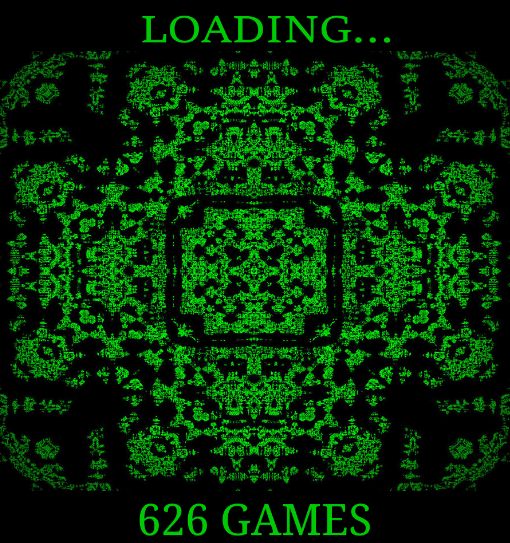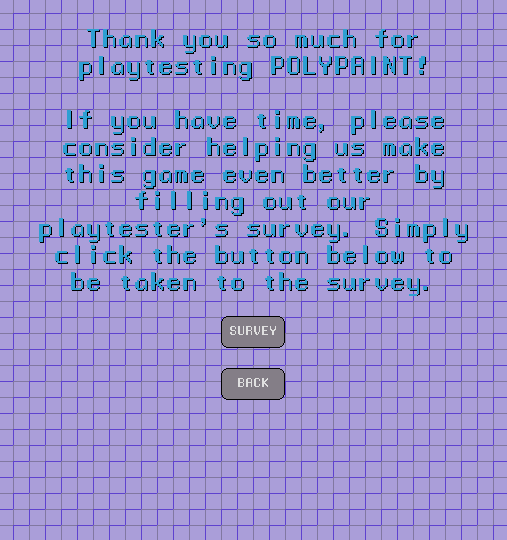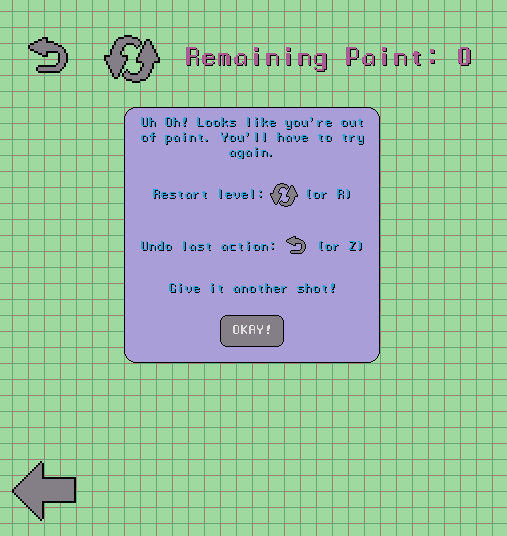Playtesting Results and Future Plans for POLYPAINT
<= Back
Playtesting POLYPAINT was a really good idea. It taught me a lot about my game. Thankfully,
it seems like I've landed on a really cool concept for a game. Everyone who playtested in person
said they enjoyed it, which is encouraging. The most important quesiton I asked in my survey was
"How long did you feel like your play session was?" After having my best friends playtest it (all
of whom are pretty good at computer games), I knew that it took approximately two hours to
complete all 30 levels. If someone felt like they were playing for less than that
amount of time, I consider that a sign that the game was engaging and captivating.
While the feedback was generally positive, I also noticed a lot of things I could have improved on.
The most important was the difficulty curve. It seemed some of the levels were in the wrong order,
and that the difficulty didn't ramp up proportionately to player experience. However, most of the
feedback I got was about quality-of-life enhancements. Thankfully, I didn't get too much feedback
on the actual design of the game, which suggests to me that I did a decent enough job when it came
to the mechanics, level design, art style, and music of the game. Here's a list of the quality-of-life
enhancements I made for the game:
-
An Undo Button.
Previously, there was a button users could press when they made a mistake that restarts the
level, replenishing all of their moves and clearing the board of any paint. I got a lot of
feedback suggesting that it would become tedious (especially for longer levels) to make it
so close to the end only to make a mouse slip and have to restart the level. I added an
"Undo" button, which simply takes back the user's last move (and all consequences of that
move). It's a simple quality-of-life enhancement, but I think players will be glad it's there.
-
A splash screen indicating the game is loading.
Looks simple, but it's much better than looking at a black box and wondering if the game crashed!

626 Games is a potential name for my own game studio. Not sure if I'll stick with it or not.
-
Made menu fonts more readable.
Some players complained that the menu font was too hard to read. A little drop shadow goes a long way!

-
Hotkeys
Rather than forcing players to click the restart / undo buttons at the top of the screen
whenever they make a mistake, I added hotkeys that do the same thing (Z for 'Undo', R for
'Restart'). Mobile players can still use the buttons while desktop players can use either
the buttons or the hotkeys. I also added this helpful message, which only displays the first
time a player runs out of paint on a level.

-
Compressed all audio to OGG format and implemented preloading
This one is a bit more of a technical "under-the-hood" change, but one of my friends suggested
compressing all my audio to OGG format. This was a really good idea, as it cut my load times
down from about a minute to less than two seconds. Additionally, I decided to implement preloading.
That means that the game audio (among other heavy resources) are loaded into the computer's memory
while the loading screen is showing so that they can be accessed faster. It's a bit of a tradeoff,
but it ultimately makes for a smoother experience. More code is executed while the game is loading,
but the benefit is that there aren't as many hiccups or stutters during the gameplay.
-
Bugfixes
Fortunately, there weren't too many bugs, but one player brought to my attention that spamming
the "restart" button will sometimes interrupt a dribble of paint without destroying it, meaning
that players can restart the level with some of the squares already painted. I fixed that annoying
problem.
Future plans
I think POLYPAINT was a great way to kick off my 2019 game design challenge, and I feel like POLYPAINT's
story is really just beginning. There are a lot of things I'd like to do in the future, but most of them amount
to simply adding more content. I've already started adding some more puzzle designs. One new mechanic is arrow
squares. They move one square in the direction of the arrow whenever they're painted:


Here are some things I'd like to do whenver I return to developing POLYPAINT:
-
IOS Support
The game is currently playable on android, but I'd like for it to be playable on IOS devices as
well to reach out to a wider audience. Apple has made some... unfortunate decisions when
it comes to developing for IOS. Long story short, it's a pain in the butt to develop IOS applications
if you don't have access to an apple device (not just an IOS device to test on, but a macintosh to
actually build and deploy from).
-
More levels
When I playtested the game, I had 30 levels. There are now 40. I'd like to continue developing levels
and possibly continue to develop new puzzle elements. The arrow squares are pretty cool, but I have
even more ideas I'd like to tinker around with.
-
More music
The game currently loops between two different songs. They're both awesome, but I'd like for there to
be a couple more to put players in the puzzle-solving mood.
-
A level editor
This is the big one. I'd really like for passionate players to be able to contribute to POLYPAINT
if they want to. I've already had a few playtesters tell me they'd love to develop some of their
own puzzle ideas for the game, so I figure the best way to appeal to that sort of player is to
provide a level editor. Designing a good level editor (and a way to share custom levels with other
players) is a project about as big as designing the game itself, so I only want to commit to this
if I know I have the resources for it.
Bye bye to January
Well, folks, that's it for January. These articles were all written after January was already over, but
I plan on providing regular update articles weekly to show my progress along my 2019 game design challenge.
I hope you enjoyed reading about POLYPAINT as much as I've enjoyed working on it. See you in February!
<= Back




